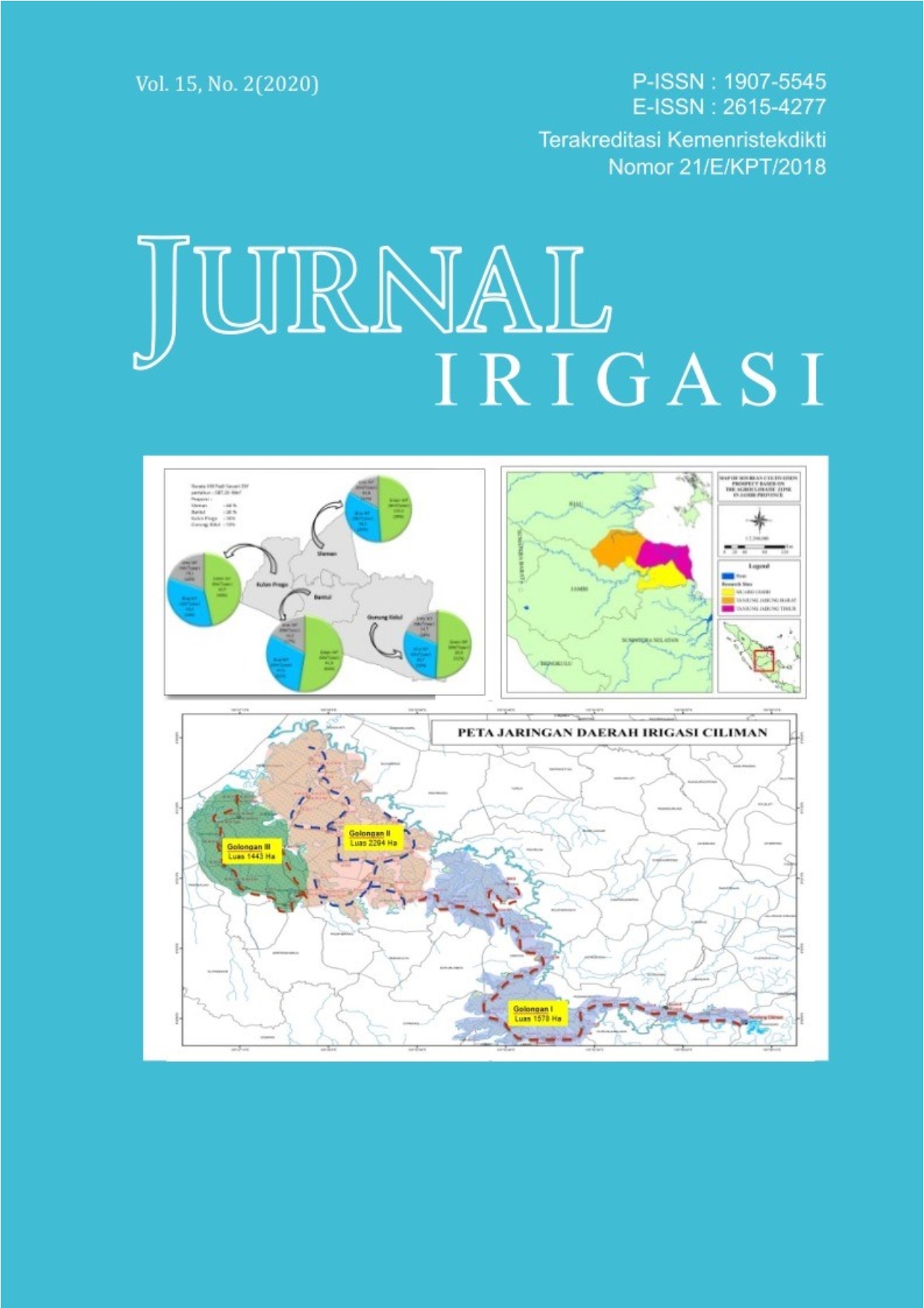Soybean cultivation prospect based on crop water requirements and the agroclimatic zone in Jambi Province
DOI:
https://doi.org/10.31028/ji.v15.i2.85-94Keywords:
Cropwat model, Oldeman classification, water balance, evapotranspiration, crop water requirement, water availabilityAbstract
Soybean (Glicine max) has the potential to be developed because it cannot only be processed into foodstuffs but also become livestock feed. In addition to using technology, enhancement of crop production can be done by looking at water availability and pay attention to the weather factors, especially to increase crop intensity. This research aims to determine the crop water requirements based on the agroclimatic zone. The quantitative descriptive analysis and data processing were conducted using the Cropwat model. This model was created by FAO specialists to provides an opportunity for automation of all the necessary calculations for evapotranspiration determination. Cropwat is an easy-to-operate software that can minimize human error. Climate classification was identified based on precipitation data in Jambi province respectively in Muaro Jambi Regency at Sultan Thaha Station, Jambi Palmerah, and Depati Parbu. The agroclimatic zone for those areas, respectively, are D1, D2, and E2. Based on the rainfall, all three districts are feasible for soybean cultivation with average rainfall between 127.11 mm - 192.51 mm per month. The amount of crop water requirements is also an essential factor for cultivating a plant so that the water can be administered according to the needs of plants and can provide optimal production. Based on water balance, the surplus in Muaro Jambi Regency Jambi Province occurs in January, February, March, April, September, October and December. East Tanjung Jabung Regency surplus is in January, February, March and April. West Tanjung Jabung Regency surplus occurs in January, February, March, October, November and December. The results of this calculation indicate that Jambi Province has the potential to cultivate soybean plants because they have sufficient water availability.
Downloads
References
Dinas Pertanian Tanaman Pangan. (2015). Laporan Tahunan. Jambi, Indonesia: Dinas Pertanian Tanaman Pangan.
Direktorat Irigasi dan Rawa. (2013). Standar Perencanaan Irigasi-Kriteria Perencanaan Bagian Perencanaan (KP-01). Jakarta: Direktorat Jenderal Sumber Daya Air, Kementerian Pekerjaan Umum.
Fadholi, A., & Supriatin, D. (2012). Sistem pola tanam di wilayah Priangan berdasakan klasifikasi iklim Oldeman. Jurnal Geografi Gea, 12(2), 61-70.
Hansen, V. E., Israelsen, O. W., & Stringham, G. E. (1979). Irrigation Principles and Practices (4th ed). New York, USA: John Wiley and Sons.
Irmak, S., Specht, J. E., Odhiambo, L. O., Rees, J. M., & Cassman, K. G. (2014). Soybean yield, evapotranspiration, water productivity, and soil water extraction response to subsurface drip irrigation and fertigation. Transactions of the ASABE, 57(3), 729-748.
Manik, T. K., Rosadi, R. B., & Karyanto, A. (2012). Evaluasi metode Penman-Monteith dalam menduga laju evapotranspirasi standar (ETo) di dataran rendah propinsi Lampung, Indonesia. Jurnal Keteknikan Pertanian, 26(2), 121-128. https://doi.org/10.19028/jtep.26.2.121-128
Munir, A. (2012). Peningkatan produktivitas dan efisiensi air dalam pertanian madura. Jurnal Agroekoteknologi, 5(2), 125-131.
Musa, N. (2012). Penentuan masa tanam jagung (Zea mays L.) berdasarkan curah hujan dan analisis neraca air di Kabupaten Pohuwato. Jurnal Agroteknotropika, 1(1), 23-27.
Oldeman, L. R., & Syarifuddin. (1977). An Agroclimates Map of Sulawesi. Bogor, Indonesia: IPB Press.
Purba, J. H. (2011). Kebutuhan dan cara pemberian air irigasi untuk tanaman padi sawah (Oryza sativa L.). Widyatech: Jurnal Sains Dan Teknologi, 10(3), 145-155.
Pusat Pendidikan dan Pelatihan Sumber Daya Air dan Konstruksi. (2017). Modul Hidrologi, Kebutuhan, dan Ketersediaan Air (Modul No. 5). Bandung, Indonesia: Pusat Pendidikan dan Pelatihan Sumber Daya Air dan Konstruksi.
Rizal, F., Alfiansyah, & Rizalihadi, M. (2014). Analisa perbandingan kebutuhan air irigasi tanaman padi metode konvensional dengan metode “System of Rice Intensification†(SRI) organik. Jurnal Teknik Sipil Pascasarjana Universitas Syiah Kuala, 3(4), 67-76.
Surendran, U., Sushanth, C. M., Mammen, G., & Joseph, E. J. (2015). Modelling the crop water requirement using FAO-CROPWAT and assessment of water resources for sustainable water resource management: A case study in Palakkad District of humid tropical Kerala, India. Aquatic Procedia, 4, 1211-1219. https://doi.org/10.1016/j.aqpro.2015.02.154
Susanawati, L. D., & Suharto, B. (2018). Kebutuhan air tanaman untuk penjadwalan irigasi pada tanaman jeruk Keprok 55 di Desa Selorejo menggunakan Cropwat 8.0. Jurnal Irigasi, 12(2), 109-118. https://doi.org/10.31028/ji.v12.i2.109-118
Tjasyono, B. (2004). Klimatologi. Bandung, Indonesia: Institut Teknologi Bandung.
Downloads
Published
How to Cite
Issue
Section
License
This work is licensed under a Creative Commons Attribution-ShareAlike 4.0 International License.
